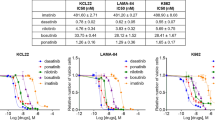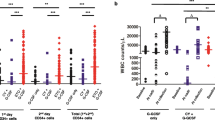Summary
The novel AKT inhibitor perifosine possesses myelopoiesis-stimulating effects in rodents. We studied the in vitro effects of the novel agents perifosine, bortezomib and lenalidomide in addition to adriamycin against normal human hematopoietic progenitor cells (HPC) using different clonogenic and non-clonogenic assays. All agents inhibited colony-forming unit (CFU) formation, perifosine inhibiting mainly CFU-granulocyte/macrophage formation and the other agents burst-forming unit-erythroid formation. Perifosine combined with lenalidomide or adriamycin tended to act antagonistically in suppressing CFU formation. Despite their inhibition of CFU formation, perifosine, bortezomib and lenalidomide induced only slight or moderate cytotoxicity in CD34+ selected HPC, as assessed using different assays such as flow cytometry-based detection of activated caspases and immunohistochemistry studies (e.g., Ki-67 staining). In contrast to its myelopoiesis-stimulating effects in rodents, perifosine - like bortezomib and lenalidomide - suppresses the clonogenic potential of HPC from healthy donors in vitro and thus probably plays no role in preventing neutropenia or in shorting its duration after intensive chemotherapy. However, all these novel agents typically induce only slight or moderate suppression of the clonogenic potential or loss of viability of normal HPC at clinically achievable plasma concentrations, assuming that hematoxicity is manageable and functional HPC can be collected after treatment with these compounds.




Similar content being viewed by others
References
Gills JJ, Dennis PA (2009) Perifosine: update on a novel Akt inhibitor. Curr Oncol Rep 11:102–110
Unger C, Berdel W, Hanauske AR et al (2010) First-time-in-man and pharmacokinetic study of weekly oral perifosine in patients with solid tumours. Eur J Cancer 46:920–925
Leighl NB, Dent S, Clemons M et al (2008) A Phase 2 study of perifosine in advanced or metastatic breast cancer. Breast Cancer Res Treat 108:87–92
Richardson P, Wolf J, Jakubowiak A et al (2008) Phase I/II results of a multicenter trial of perifosine (KRX-0401) + bortezomib in patients with relapsed or relapsed/refractory multiple myeloma who were previously relapsed from or refractory to bortezomib. Blood 112(Suppl 11):870
Pal SK, Reckamp K, Yu H et al (2010) Akt inhibitors in clinical development for the treatment of cancer. Expert Opin Investig Drugs 19:1355–1366
Van der Luit AH, Vink SR, Klarenbeek JB et al (2007) A new class of anticancer alkylphospholipids uses lipid rafts as membrane gateways to induce apoptosis in lymphoma cells. Mol Cancer Ther 6:2337–2345
Gajate C, Mollinedo F (2007) Edelfosine and perifosine induce selective apoptosis in multiple myeloma by recruitment of death receptors and downstream signaling molecules into lipid rafts. Blood 109:711–719
Hideshima T, Catley L, Raje N et al (2007) Inhibition of Akt induces significant downregulation of survivin and cytotoxicity in human multiple myeloma cells. Br J Haematol 138:783–791
Fu L, Kim YA, Wang X et al (2009) Perifosine inhibits mammalian target of rapamycin signaling through facilitating degradation of major components in the mTOR axis and induces autophagy. Cancer Res 69:8967–8976
Sun SY (2010) Enhancing perifosine’s anticancer efficacy by preventing autophagy. Autophagy 6:184–185
Zerp SF, Vink SR, Ruiter GA et al (2008) Alkylphospholipids inhibit capillary-like endothelial tube formation in vitro: antiangiogenic properties of a new class of antitumor agents. Anticancer Drugs 19:65–75
Catley L, Hideshima T, Chauhan D et al (2007) Alkyl phospholipid perifosine induces myeloid hyperplasia in a murine myeloma model. Exp Hematol 35:1038–1046
Richardson P, Mitsiades C, Laubach J et al (2010) Lenalidomide in multiple myeloma: an evidence-based review of its role in therapy. Core Evid 4:215–245
Ferrajoli A, Lee BN, Schlette EJ et al (2008) Lenalidomide induces complete and partial remissions in patients with relapsed and refractory chronic lymphocytic leukemia. Blood 111:5291–5297
Kotla V, Goel S, Nischal S et al (2009) Mechanism of action of lenalidomide in hematological malignancies. J Hematol Oncol 2:36
Dauguet N, Fournié JJ, Poupot R et al (2010) Lenalidomide down regulates the production of interferon-gamma and the expression of inhibitory cytotoxic receptors of human Natural Killer cells. Cell Immunol 264:163–170
Görgün G, Calabrese E, Soydan E et al (2010) Immunomodulatory effects of lenalidomide and pomalidomide on interaction of tumor and bone marrow accessory cells in multiple myeloma. Blood 116:3227–3237
Chauhan D, Singh AV, Ciccarelli B et al (2010) Combination of novel proteasome inhibitor NPI-0052 and lenalidomide trigger in vitro and in vivo synergistic cytotoxicity in multiple myeloma. Blood 115:834–845
Verhelle D, Corral LG, Wong K et al (2007) Lenalidomide and CC-4047 inhibit the proliferation of malignant B cells while expanding normal CD34+ progenitor cells. Cancer Res 67:746–755
Ximeri M, Galanopoulos A, Klaus M et al (2010) Hellenic MDS Study Group. Effect of lenalidomide therapy on hematopoiesis of patients with myelodysplastic syndrome associated with chromosome 5q deletion. Haematologica 95:406–414
Raza A, Reeves JA, Feldman EJ et al (2008) Phase 2 study of lenalidomide in transfusion-dependent, low-risk, and intermediate-1 risk myelodysplastic syndromes with karyotypes other than deletion 5q. Blood 111:86–93
Sekeres MA, Maciejewski JP, Giagounidis AA et al (2008) Relationship of treatment-related cytopenias and response to lenalidomide in patients with lower-risk myelodysplastic syndromes. J Clin Oncol 26:5943–5949
Sekeres MA, List AF, Cuthbertson D et al (2010) Phase I combination trial of lenalidomide and azacitidine in patients with higher-risk myelodysplastic syndromes. J Clin Oncol 28:2253–2258
Mitsiades CS, Hideshima T, Chauhan D et al (2009) Emerging treatments for multiple myeloma: beyond immunomodulatory drugs and bortezomib. Semin Hematol 46:166–175
Schmidt-Hieber M, Busse A, Reufi B et al (2009) Bendamustine, but not fludarabine, exhibits a low stem cell toxicity in vitro. J Cancer Res Clin Oncol 135:227–234
Blau IW, Elstner E, Waechter M et al (1989) Sensitivity of CFU-GM from normal human bone marrow and leukaemic clonogenic cells (CFU-L) from blood of patients with myelogenous leukaemia to 3′-deoxy-3′-fluorothymidine in comparison to 3′-azido-3′-deoxythymidine. Blut 59:455–457
Schmidt-Hieber M, Dabrowski R, Weimann A et al (2010) In vitro cytotoxicity of the novel antimyeloma agents perifosine, bortezomib and lenalidomide against different cell lines. Invest New Drugs 2010 Nov 16 [Epub ahead of print].
Busse A, Kraus M, Na IK et al (2008) Sensitivity of tumor cells to proteasome inhibitors is associated with expression levels and composition of proteasome subunits. Cancer 112:659–670
Reed LJ, Muench H (1938) A simple method of estimating fifty per cent endpoints. Am J Hyg 27:493–497
Crul M, Rosing H, de Klerk GJ et al (2002) Phase I and pharmacological study of daily oral administration of perifosine (D-21266) in patients with advanced solid tumours. Eur J Cancer 38:1615–1621
Papa V, Tazzari PL, Chiarini F et al (2008) Proapoptotic activity and chemosensitizing effect of the novel Akt inhibitor perifosine in acute myelogenous leukemia cells. Leukemia 22:147–160
Zonder JA, Crowley J, Hussein MA et al (2010) Lenalidomide and high-dose dexamethasone compared with dexamethasone as initial therapy for multiple myeloma: a randomized Southwest Oncology Group trial (S0232). Blood 116:5838–5841
Chen N, Lau H, Kong L et al (2007) Pharmacokinetics of lenalidomide in subjects with various degrees of renal impairment and in subjects on hemodialysis. J Clin Pharmacol 47:1466–1475
Ebert BL, Galili N, Tamayo P et al (2008) An erythroid differentiation signature predicts response to lenalidomide in myelodysplastic syndrome. PLoS Med 5:e35
Pal R, Monaghan SA, Hassett AC et al (2010) Immunomodulatory derivatives induce PU.1 down-regulation, myeloid maturation arrest, and neutropenia. Blood 115:605–614
Reece DE, Sullivan D, Lonial S et al (2011) Pharmacokinetic and pharmacodynamic study of two doses of bortezomib in patients with relapsed multiple myeloma. Cancer Chemother Pharmacol 67:57–67
Orlowski RZ, Stinchcombe TE, Mitchell BS et al (2002) Phase I trial of the proteasome inhibitor PS-341 in patients with refractory hematologic malignancies. J Clin Oncol 20:4420–4427
Richardson PG, Barlogie B, Berenson J et al (2003) A phase 2 study of bortezomib in relapsed, refractory myeloma. N Engl J Med 348:2609–2617
Bramwell VH, Anderson D, Charette ML (2000) Doxorubicin-based chemotherapy for the palliative treatment of adult patients with locally advanced or metastatic soft-tissue sarcoma: a meta-analysis and clinical practice guideline. Sarcoma 4:103–112
Ehninger G, Stocker HJ, Proksch B et al (1980) The pharmacokinetics of adriamycin and adriamycin-metabolites (author’s transl). Klin Wochenschr 58:927–934
Kumar S, Giralt S, Stadtmauer EA et al (2009) International Myeloma Working Group. Mobilization in myeloma revisited: IMWG consensus perspectives on stem cell collection following initial therapy with thalidomide-, lenalidomide-, or bortezomib-containing regimens. Blood 114:1729–1735
Acknowledgements
The authors would like to thank the Dr. Werner Jackstädt Foundation for a grant supporting the work of M. Schmidt-Hieber. The authors also thank Dr. J. Weirowski for providing valuable editorial assistance.
Conflict of interest disclosure statement
B. Aicher is employed at Æterna Zentaris GmbH (Frankfurt/Main, Germany), and has stock/stock options at this company. The other authors have declared no conflicts of interest.
Author information
Authors and Affiliations
Corresponding author
Additional information
MSH, ET and IWB designed the study. MSH, RD, BA, PL, AB, CTB and BR performed the experiments and/or analyzed data. MSH wrote the manuscript. All authors approved the final version of the manuscript.
Electronic supplementary material
Below is the link to the electronic supplementary material.
Supplemental Figure 1
Depiction of exemplary Ki-67 and caspase-3 staining of CD34+ selected PB HPC after 24 h incubation with lenalidomide (1 µM). Percentages refer to positive cells. Tonsilar tissue with follicular hyperplasia was used as a positive control with a high Ki-67 proliferative index and numerous cleaved caspase-3+ apoptotic cells within the germinal centers. (DOC 683 kb)
Rights and permissions
About this article
Cite this article
Schmidt-Hieber, M., Dabrowski, R., Aicher, B. et al. In vitro effects of perifosine, bortezomib and lenalidomide against hematopoietic progenitor cells from healthy donors. Invest New Drugs 30, 1396–1403 (2012). https://doi.org/10.1007/s10637-011-9705-6
Received:
Accepted:
Published:
Issue Date:
DOI: https://doi.org/10.1007/s10637-011-9705-6




